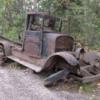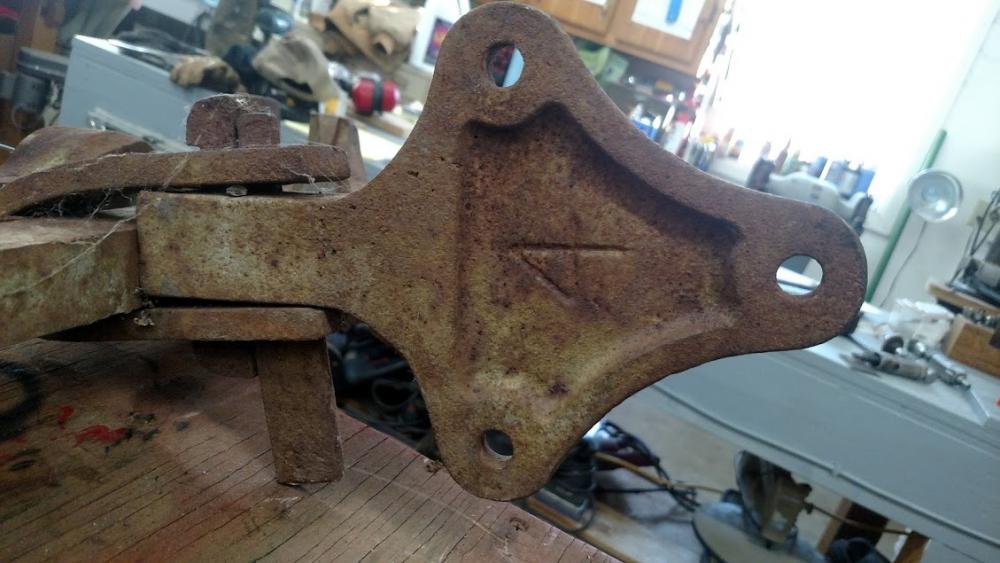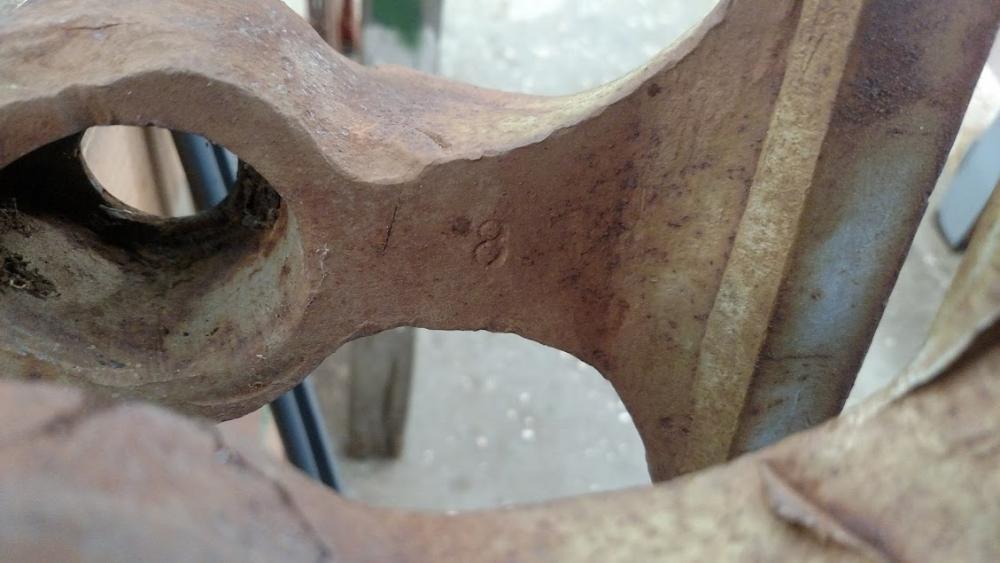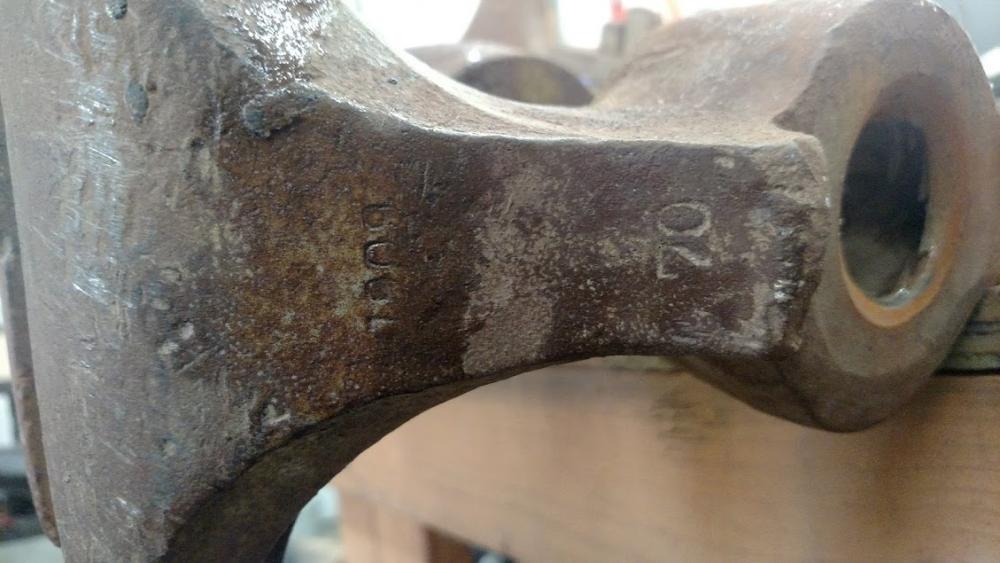-
Posts
27 -
Joined
-
Last visited
Content Type
Profiles
Forums
Articles
Gallery
Downloads
Events
Posts posted by SBOhio
-
-
Purchased this a while back and couldn't see anything on it. Getting it set up now and I found some numbers that I hope help with figuring out it's history. The front, moveable jaw has "1909" stamped on near the top and "70" underneath. The mounting bracket is stamped with a large "4" on the bottom side. Both Jaws each have an "8" stamped on the inside. They measure 5 3/8" across. Thanks ahead of time for any help.
-
Les, I'm thinking about making one for myself. Was that cold rolled?
-
Doughnuts aren't age regulated, and go over fairly well too. :D
2 dozen doughnuts got me 6 truckloads of asphalt road grindings one time. The unexpected part was they shut the whole road project down and had a doughnut break!
-
Thats a great looking anvil. I'm also just getting started. Do you know what the purpose is of the the little side shelf?
-
I would have bought that beer. We had caribou steak and fried oysters at West Rib Pub. Is the purpose of the fire brick just to prevent burnout? Are they just layed up loose?
-
That's a BIG firepot alright. Do you weld? I have a 3''x4' forge table it'd drop right into, as in perfect fit. If I had good access to coal I might even be using it.
Filling the gap is easy enough, wood stove rope is easy enough, you can even push it in with a flattened stick like chinking a log cabin wall.
Frosty The Lucky.
I do weld a little. Mostly stick. Just picked up a Miller211 MIG. I've been looking for plans or pictures of larger forges. I got this one to get started. I will get the bolts repaced and try the wood stove rope or furnace caulk. I think I road the train by your house last summer from Anchorage to Talkeetna. Met the mayor, Stubs the Cat. Are you just west of Wasilla? What a state. My wife and I loved it.
-
That's a BIG firepot alright. Do you weld? I have a 3''x4' forge table it'd drop right into, as in perfect fit. If I had good access to coal I might even be using it.
Filling the gap is easy enough, wood stove rope is easy enough, you can even push it in with a flattened stick like chinking a log cabin wall.
Frosty The Lucky.
I do weld a little. Mostly stick. Just picked up a Miller211 MIG. I've been looking for plans or pictures of larger forges. I got this one to get started. I will get the bolts repaced and try the wood stove rope or furnace caulk. I think I road the train by your house last summer from Anchorage to Talkeetna. Met the mayor, Stubs the Cat. Are you just west of Wasilla? What a state. My wife and I loved it.
-
Greetings SB,
That's a lot of firepot for that lil forge... I think you will also find that the stack is too small.. 10'' works best.. That firepot was designed for a 3ft square school or repair shop forge for much bigger work than you have forge.. By the way replacement if you could find one is about 300. Repair would it would be best just to caulk up the separation and forget it.. Per Thomas.. Again the design is for a very large air volume hence the bulbus look and to remove the clinker breaker.. I would put that one aside and make or buy a smaller one. I wish you well
Forge on and make beautiful things
Jim
The fire pot is what caught my eye. After your comment about the size I measured it this afternoon. It's 8 x 12" and about 3 1/2" deep. How large would make the fire pot for this size forge? I may try and save this one for a larger permanant forge. I'm going to try to set this one up to roll out of woodworking shop to safely work outside. I don't have a good safe area to work just yet inside. I thought the forge would make a good starter forge. I will see if I can open the hood up to 10". It's 8" opening and stainless.
-
Does it just need the bolts replaced to snug it up? If you don't want to fiddle with that I'd try furnace cement.
Yes the bolts area corroded down to about 1/8" diameter at the end where the gap is. They will have to be drilled and tapped.
-
'?do=embed' frameborder='0' data-embedContent>> some light reading!
Thanks for the link Y2.
-
-
-
I picked up this small forge. It's my 1st forge. There is a gap between fire pot and tuyere. As you see in the picture there appears there was something black between the two that is burnt out. What can I use to seal this? Also was wondering if anyone recognizes the forge or the firepot/tuyere as commercially produced or if you think its homemade?
-
It is 411. Everything I've read is that it 411 lbs., not in stone. I appreciate the help and will try to close the deal!
-
$1000. is the anvil only. I don't know what he wants for the base. I'll have to ask. Do you think it's to wide at the bottom to work comfortably?
-
Your picture is great. Any one would be proud to work in that shop. I am in the same boat as you. This anvil hunting is a little like dating when I was younger. Little bit nervous and you have to work at a it a little. Good luck with your search.
-
The anvil looks like a dandy, If it is in your price range, BUY IT NOW. The top plate looks clean, from the pic I don't see big chips taken out of it. Hay BUDDENs were not cast anvils, each was forged using big steam hammers so the lines are not cookie cutter perfect. The bottom of an anvil is for support and weight/mass not a working surface, so how it looks isn't a big deal. the S/N dates it to 1904. If those are welds they are not in the working area of the anvil so not an issue. You have ring and rebound so you know the top plate is still attached and it is still hard.
If it was me and the price was reasonable and in my range, I would not hesitate to buy it.
Mark
I guess my only concern would be if the cracks opened up down the road. What do you think of the base? I thought it was a little hard to get your feet close but it's a beast!
-
Looking at the pics, nothing. They are not in critical areas, and they do not go all around. I am guesssing that they are just surface, and were not repairs.
If it was in my price range I would have no problem buying that Hay-Budden.
How much are they asking?$2.50/lb.. $1000. is still a chunk of change and I was worried about them opening up down the road. Your right the vertical weld looks like a test weld. The one under horn is more concerning. Do you think its possible the horn could have been broke off?
-
Something may have been welded to it at some point, then removed. OR, someone was testing the settings on a welder for a job.
Looks good, have fun with it.I haven't bought it yet. I don't know what to do about these potential welds.
-
- Ok I have some more info on the Hay Buddon. Serial # on the foot appears to be 89851. I can't see anything after the 1. It is pretty ruff after that. After removing the paint on the face the rebound increase incredibly. I would put it at 80-85% rebound! The bad new is what appears to be a weld under the horn. I am not sure if this is a weld or not. Could a Hay Buddon of this age have been cast this ruffly? The lower part of this whole anvil is ruff. The other bad news is what appears as a 4" long vertical weld under the heal. Now I don't know what to do. The rebound is great. The ring on the face is decent and not so good on the sides. This anvil still has 200 lbs of mass above any potential welds. I am new to blacksmithing and don't expect to be going at this with a large sledge anytime soon.
-
Is there a way to get close to judging hardness? I believe most files are 60 and from what I've read most of these older anvils are softer. The face and edges are in awful good shape. I couldn't see any separation. I will get the paint off. Thanks for all the help.
-
Hi SB, welcome to IFI.
I am no expert in anything...but If the top of the anvil is covered in paint it could kill the ring and rebound. If the owner is willing to let you clean the face off, clean it to bare metal with a wire wheel and try the rebound again. Also ensure the ball you are using is a hardened one. I have a large soft steel bearing that shaws horrible rebound on anything. Try a bigger ball pein/pien/peen after you strip the paint and see if that gives a better result, does the hammer leave a divot if you hit it pretty hard? The base it sits on can indeed dampen the ring, but shouldn't affect rebound, the paint could affect both though..
While you are cleaning the face, stand in front of the horn and clean the left foot, there should be a S/N there which can give you a date of manufacture.
Early HBs had a welded on hardened steel plate, as I recall the rest of the anvil is wrought, after I think 1903?? (Have to look in AIA for the year) HB went to a 2 piece anvil with the top half being tool steel, bottom being steel or possibly wrought, Mine (1918) looks like it has been forged from steel
This one looks like it has a plate about an 1" thick forged on top. If it is one of the earlier ones do you know if being wrought would cause it to have a dead ring? I will try to get the top stripped as soon as possible and look for that serial #.
-
Yes paint on the face will preclude the ball bearing test working. How it is mounted on the base might quiet it down. You won't be able to get a good ring with a heavy layer of paint either as like the ball bearing the face paint will squish rather than the face dealing with the energy. Without stripping the paint you are looking at a pig in a poke!
Have you ever heard of paint stripper being a problem? It looks like old enamel and I think a good stripper would take it off.
-
Just wanted take a moment to introduce myself and say hello. I'm new to blacksmithing and in my search for my 1st anvil I stumbled on a large 400 lb Hay Buddon. I have done a lot of research and know they are a really respected and prized anvil. The problem is it has almost no rebound with a 1" ball bearing. I would estimate it to be about 20%. The sound with small ball peen is more of a dead thud or low/dead ring also. This anvil is heavily painted including the face. I would quess it was painted more than 20 years ago. Would the paint kill rebound and sound? I have looked at some larger Peter Writes that rang like a church bell. It is sitting on a large commercial looking base. The base is probably 24 x 24" at the bottom, made of steel, and a large hole on all four sides. Would the base soak up the rebound and sound? He has given me permission to strip it before I buy it. From what I've found fire, a loose top plate, or cracks are the primary suspects. Can anyone explain the two different production methods for Hay Buddons? Are these larger anvils just flat sounding? Any thoughts on what to look for would be helpful.












Post Vice ID Help?
in Vises
Posted
I will get an overall picture posted. Took is down to do a little cleaning up. I think It's missing the thrust washer on the moveable jaw. I was thinking this was the date and year built also.